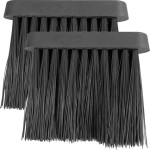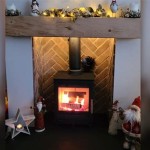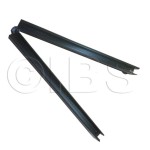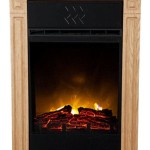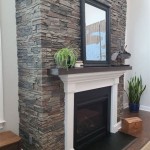Corner Fireplace Surrounds: Design, Materials, and Installation Considerations
Corner fireplaces present a unique set of design challenges and opportunities within a home. Unlike traditional fireplaces that are centered on a wall, a corner placement often forces a re-evaluation of room layout and focal point establishment. A well-chosen and properly installed corner fireplace surround is crucial not only for aesthetic enhancement but also for functional safety and optimization of hearth efficiency.
The purpose of a fireplace surround extends beyond mere decoration. It serves to frame the firebox, creating a visually appealing focal point, and to protect the surrounding wall from the intense heat generated by the fire. Furthermore, the surround can contribute to the overall thermal efficiency of the fireplace by reflecting heat back into the room. The choice of materials, design, and installation method for a corner fireplace surround significantly impacts its performance and longevity.
Design Options for Corner Fireplace Surrounds
The design of a corner fireplace surround should complement the existing architectural style of the room. Whether the aesthetic leans towards traditional, modern, rustic, or eclectic, the surround should seamlessly integrate into the overall design scheme. Considerations include the shape, size, and detailing of the surround, as well as its relationship to the surrounding walls and furniture.
For traditional settings, a surround crafted from wood, often featuring intricate moldings and carvings, is a common choice. Options range from simple, clean lines to elaborate, ornate designs. The wood can be stained, painted, or left natural to suit the desired look. Mantel shelves are frequently incorporated into traditional designs, providing a surface for displaying decorative items. Fireplace surrounds in traditional style can be designed with large pilasters or columns to enhance the design.
Modern designs tend to favor clean lines and minimalist aesthetics. Materials such as concrete, metal, and glass are frequently employed. The focus is often on simplicity and functionality, with minimal ornamentation. A sleek, unadorned concrete surround, for example, can provide a contemporary and industrial feel. Consider a dark color for the contemporary design.
Rustic designs often incorporate natural materials such as stone, brick, and reclaimed wood. The goal is to create a warm and inviting atmosphere, evoking a sense of connection to nature. A stone surround, for instance, can add texture and character to a room. The incorporation of a chunky wooden beam as a mantel can further enhance the rustic aesthetic.
The corner placement itself dictates certain design considerations. The angle of the corner influences the shape and size of the surround. A symmetrical design may work well for a corner with a 90-degree angle, while an asymmetrical design may be more suitable for a corner with a different angle. The overall dimensions of the room also play a role in determining the appropriate size of the surround. A surround that is too large can overwhelm a small room, while one that is too small may appear insignificant in a large room.
Beyond the basic style considerations, there are numerous ways to personalize a corner fireplace surround. Decorative tiles, custom metalwork, and unique lighting can all be incorporated to create a one-of-a-kind focal point. The choice of accessories, such as fireplace tools and screens, can also contribute to the overall aesthetic.
Material Selection for Corner Fireplace Surrounds
The choice of materials for a corner fireplace surround is critical for both aesthetic and functional reasons. The material must be able to withstand the heat generated by the firebox, while also complementing the overall design of the room. Common materials include wood, stone, brick, concrete, metal, and tile, each with its own unique properties and characteristics.
Wood is a popular choice for traditional fireplace surrounds due to its versatility and warmth. It can be easily shaped and carved, allowing for intricate detailing. However, wood is also combustible, so it must be properly protected from the heat of the firebox. This typically involves using non-combustible materials, such as brick or stone, to line the firebox and provide a heat shield. The distance between the wood and the firebox must adhere to local building codes to prevent fire hazards. Different types of wood, such as various hardwoods or engineered wood products, can be used depending on budget and design preference.
Stone is a durable and aesthetically appealing option for fireplace surrounds. It is naturally non-combustible and can withstand high temperatures. Stone surrounds come in a variety of styles, from rustic fieldstone to polished marble. The cost of stone can vary widely, depending on the type and quality of the material. Installation can also be more complex than with other materials, requiring specialized tools and expertise.
Brick is another durable and fire-resistant material that is commonly used for fireplace surrounds. It offers a classic and timeless look, and can be easily incorporated into both traditional and modern designs. Brick is also relatively inexpensive compared to stone. It can be painted, stained, or left natural to achieve the desired aesthetic. Brick is very durable and can be an appealing option.
Concrete is a versatile material that is gaining popularity in modern fireplace surround designs. It can be cast into various shapes and sizes, allowing for a high degree of customization. Concrete is also non-combustible and can withstand high temperatures. It can be stained or polished to achieve a variety of finishes. A concrete fireplace surround will also add mass to the room which will aid in heating.
Metal, such as steel or cast iron, is often used in contemporary fireplace surrounds. It offers a sleek and industrial look. Metal is also non-combustible and can withstand high temperatures. However, it can become very hot to the touch, so it is important to ensure that it is properly insulated or shielded. Consider a metal design that is modern, but not too industrial.
Tile is a versatile option that can be used to create a variety of different looks, from traditional to modern. It is available in a wide range of colors, patterns, and textures. Tile is also non-combustible and easy to clean. However, it can be more expensive than other materials, and installation can be time-consuming. The design options of tile are infinite. Consider creating a unique design with the tile.
When selecting materials for a corner fireplace surround, it is important to consider the overall budget, the desired aesthetic, and the functional requirements of the fireplace. The material should be durable, fire-resistant, and compatible with the existing architectural style of the room.
Installation Considerations for Corner Fireplace Surrounds
Proper installation of a corner fireplace surround is essential for both safety and aesthetic reasons. The installation process involves several steps, including preparing the wall, installing the surround, and finishing the details. It is crucial to follow local building codes and manufacturer's instructions to ensure a safe and compliant installation.
Before beginning the installation process, it is important to prepare the wall. This may involve removing any existing trim or paneling, as well as cleaning and leveling the surface. The wall should be structurally sound and able to support the weight of the surround. If the wall is not strong enough, it may need to be reinforced.
The installation method will vary depending on the type of surround and the materials used. For wood surrounds, it is important to ensure that there is adequate clearance between the wood and the firebox. This typically involves installing a non-combustible barrier, such as brick or stone, to protect the wood from the heat. The wood can be attached to the wall using screws, nails, or adhesive.
For stone or brick surrounds, it is important to use a strong mortar to secure the materials to the wall. The mortar should be applied evenly and allowed to cure properly. The stones or bricks should be carefully aligned to ensure a uniform appearance. The use of a level is essential for maintaining a straight and consistent surface.
For concrete or metal surrounds, it may be necessary to use specialized fasteners or anchoring systems to secure the surround to the wall. The weight of the surround should be properly distributed to prevent stress on the wall. It is important to follow the manufacturer's instructions carefully when installing these types of surrounds.
After the surround is installed, it is important to finish the details. This may involve caulking any gaps or seams, painting or staining the surround, and installing any decorative trim or accessories. The finishing touches can make a significant difference in the overall appearance of the fireplace.
When installing a corner fireplace surround, it is important to consider the placement of electrical outlets and wiring. If there are any electrical components near the fireplace, they must be properly insulated and protected from the heat. It is also important to ensure that there is adequate ventilation around the fireplace to prevent the buildup of carbon monoxide and other harmful gases.
If there is a gas line, it is recommended to hire a qualified technician.
It is often recommended to hire a professional contractor to install a corner fireplace surround. A professional contractor has the experience and expertise to ensure that the installation is done safely and correctly. They can also help with selecting the right materials and designing the surround to complement the overall design of the room. A professional can also ensure compliance with local building codes and regulations.

Corner Fireplace Installation

Corner Fireplace Installation

How To Make A Corner Fireplace Mantel Look Good 15 Examples

How To Decorate A Corner Fireplace Mantel For The Holidays Making It In Mountains

Corner Fireplace Ideas Design

ᑕ❶ᑐ Corner Fireplace Save Space In Your Room Magikflame Blog

New Free Corner Fireplace Tile Ideas Enough Time For Anyone Exposed Bricks Framing Your Firepla White Stone Fireplaces Surround Modern

Modern Farmhouse Mantel Makeover Corner Fireplace Her Tool Belt

Corner Fireplace Installation

Cozy Corner Fireplace Ideas Barron Designs

